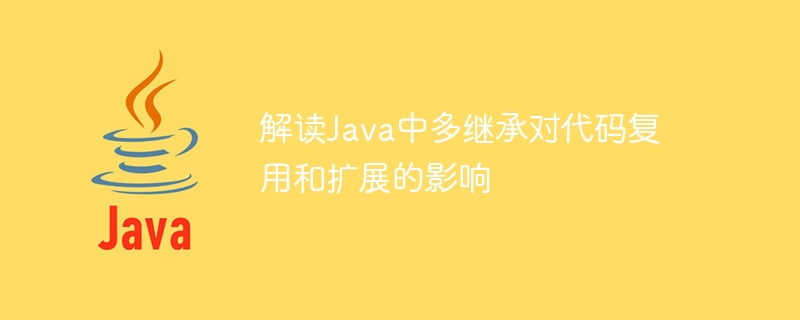

To understand the impact of multiple inheritance on code reuse and expansion in Java, specific code examples are required
Multiple inheritance means that a class can inherit from multiple parent classes at the same time Properties and methods. In Java, due to the limitations of single inheritance, multiple inheritance is not supported. However, Java implements a feature similar to multiple inheritance through interfaces, which is called multiple inheritance of interfaces. Interfaces allow a class to implement multiple interfaces, thereby achieving the effect of multiple inheritance. This article will explore the impact of multiple inheritance on code reuse and extension in Java and provide specific code examples.
First, let us look at the impact of multiple inheritance on code reuse. One of the biggest advantages of multiple inheritance is enhanced code reusability. By inheriting from classes that implement different interfaces, we can reuse methods and properties from each interface into new classes. The following is a specific example to further illustrate:
// 定义一个接口A
interface A {
void methodA();
}
// 定义另一个接口B
interface B {
void methodB();
}
// 实现类C实现了接口A和B
class C implements A, B {
public void methodA() {
System.out.println("实现了接口A中的方法");
}
public void methodB() {
System.out.println("实现了接口B中的方法");
}
}
public class MultipleInheritanceExample {
public static void main(String[] args) {
C c = new C();
c.methodA(); // 输出:实现了接口A中的方法
c.methodB(); // 输出:实现了接口B中的方法
}
}In the above example, interface A and interface B provide different methods. Class C can inherit both interface A and interface B by implementing these two interfaces. method in. In this way, we can not only access method methodA through class C, but also access method methodB through class C, realizing code reuse.
Secondly, let us look at the impact of multiple inheritance on code expansion. Multiple inheritance allows a class to implement new functions by inheriting other interfaces or classes while maintaining its original functions. The following example will explain this concept more clearly:
// 定义一个接口Shape,包含计算面积的方法
interface Shape {
double calculateArea();
}
// 定义一个接口Color,包含获取颜色的方法
interface Color {
String getColor();
}
// 实现类Rectangle实现了接口Shape和接口Color
class Rectangle implements Shape, Color {
private double width;
private double height;
private String color;
public Rectangle(double width, double height, String color) {
this.width = width;
this.height = height;
this.color = color;
}
public double calculateArea() {
return width * height;
}
public String getColor() {
return color;
}
}
public class MultipleInheritanceExample {
public static void main(String[] args) {
Rectangle rectangle = new Rectangle(5, 10, "红色");
System.out.println("矩形的面积为:" + rectangle.calculateArea()); // 输出:矩形的面积为:50.0
System.out.println("矩形的颜色为:" + rectangle.getColor()); // 输出:矩形的颜色为:红色
}
}In the above example, the interface Shape defines the method to calculate the area, and the interface Color defines the method to get the color. By implementing these two interfaces, the Rectangle class can not only calculate the area of the rectangle, but also obtain the color of the rectangle. In this way, through multiple inheritance, we can add new functions to the class without changing the original class logic.
In summary, although Java does not support multiple inheritance, code reuse and expansion can be achieved through the multiple inheritance feature of interfaces. By inheriting from different interface implementation classes, we can reuse the methods and properties in each interface into new classes, and we can implement new functions by inheriting other interfaces or classes while maintaining the original functions. . This facilitates us to write more flexible, reusable and extensible code.
The above is the detailed content of Analysis of the impact of multiple inheritance on code reuse and extension in Java. For more information, please follow other related articles on the PHP Chinese website!




